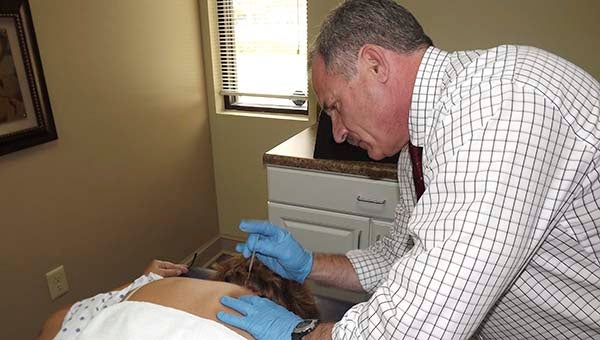Physical therapist needles patients to relieve their suffering
Published 9:49 am Wednesday, August 6, 2014

Kevin Schrack, PT, regional director of the Tidewater Physical Therapy in Franklin, aims a needle to be used on Susan Vick, who is an occupational therapist. — STEPHEN H. COWLES | TIDEWATER NEWS
FRANKLIN—Kevin Schrack knows a way to get under people’s skin that actually has them feeling better about themselves. That’s because he’s trained and certified in a technique known as dry needling, which is intended to be used therapeutically. Schrack, PT, OCS, is the regional director for the Tidewater Physical Therapy in Franklin.
He explained that dry needling uses acupuncture needles for more defined treatment of muscle pain that’s connected to trigger points. Those are areas within muscles that are “extremely tight” and cause pain that can be both local and referred. For example, a trigger point in a shoulder can cause discomfort not only in that area, but also extend down to an arm or hand.
A trained therapist such as Schrack punctures a patient’s skin with an ultra-thin needle. According to the Journal of Orthopaedic and Sports Physical Therapy, the needles can “stimulate the trigger points, muscles or connecting tissues. Dry needling may release the tight muscle bands and decrease pain.”
Discovering that more therapists are using the technique, Schrack decided to learn dry needling because, as he said, “We stay in tune with advances in our profession. It’s always been a real priority for our practice.”
He began his schooling in Newport News at the first part of this year, and finished in late May. In addition to classroom study, there were 54 hours of practical training on other therapists.
“It was intensive as I expected. You really have to know anatomy,” said Schrack, who is licensed as both a physical therapist and orthopaedic certified specialist. He added that the test — both written and practical — was “very difficult.”
Since the certification, he’s already been doing some dry needling every week, including one of his employees, Susan Vick, an occupational therapist who allowed herself to be photographed for this article.
The sight or mere thought of needles can be unsettling to some people. Asked how he persuades some patients to consider the treatment, Schrack said, “You try to talk to them…about what will happen, what are the expectations and why it can be beneficial, and then get an agreement.”
He said dry needling began in the 1970s, but it’s only been within the past five years that the interest has increased as the benefits have become more known.
Schrack credits two factors for his own interest in the work: sports and anatomy, “which I really like.” He used to run a great deal, such as cross-country in high school, as well as playing rugby in college. Today he still works out at a gym, and also plays tennis.
“These two go together and just led to this profession,” he said.
A native of Pennsylvania, he first came to Virginia with his family, where they settled in Culpepper. At age 25 Schrack started his life’s work, and was first practicing in Norfolk, followed by Northern Virginia and Virginia Beach.
With just one secretary, he established Southside Physical Therapy locally in 1992. The office merged with Tidewater Physical Therapy in 2011.
To learn more, call 562-0990, or visit at 1580 Armory Dr., Suite B, Franklin.





